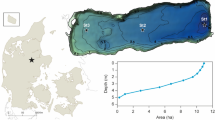Abstract
We examined whether relatively small urban ponds behave as ‘completely mixed reactors’ by measuring the stability and vertical heterogeneity of water column parameters. To do this, we measured profiles of water temperature and conductivity from the pond surface to the water-sediment interface twice during summer 2009 in 45 stormwater ponds located in the residential landscape of southern Ontario. These data were used to calculate water column stability indices and examine the relative importance of temperature and conductivity in controlling water column stratification. We also measured concentrations of dissolved oxygen (DO), dissolved organic carbon (DOC), total dissolved phosphorus (TDP),total dissolved nitrogen (TDN), particulate phosphorus and nitrogen (seston P and N), chlorophyll a (Chl-a), and total suspended solids (TSS) in surface and bottom waters. Despite their shallow depth (0.50–2.8 m), most ponds were stratified on the day of sampling and had relatively stable water columns both in June and August. Temperature differences rather than conductivity differences were better related to water column stability. Despite relatively stable water columns, vertical differences were not found for most water chemistry parameters, suggesting either recent mixing or relatively slow biogeochemical processing. Top-bottom differences were observed in June and August for DO and in June for TDN, seston N and TSS, reflecting a combination of processes influencing water column chemistry.



Similar content being viewed by others

References
Bloesch J (1994) A review of methods used to assess sediment resuspension. Hydrobiologia 284:13–18
Burns NM, Rosa F (1980) In situ measurement of the settling velocity of organic carbon particles and 10 species of phytoplankton. Limnol Oceanogr 25(5):855–864
Chiandet AS, Xenopoulos MA (2011) Landscape controls on seston stoichiometry in urban stormwater management ponds. Freshw Biol 56:519–529
Condie SA, Webster IT (2002) Stratification and circulation in a shallow turbid waterbody. Environ Fluid Mech 2(3):177–196. doi:10.1023/A:1019898931829
Fee EJ, Hecky RE, Kasian SEM (1996) Effects of lakes size, water clarity and climatic variability on mixing depths in Canadian Shield Lakes. Limnol Oceanogr 41:912–920
Goldman CR, Elser JJ, Richards RC, Reuters JE, Priscus JC, Levin AL (1996) Thermal stratification, nutrient dynamics, and phytoplankton productivity during the onset of spring phytoplankton growth in Lake Baikal, Russia. Hydrobiologia 331:9–24
Hansson L-A (1991) Factors regulating periphytic algal biomass. Limnol Oceanogr 37:322–328
Imberger J (1985) The diurnal mixed layer. Limnol Oceanogr 30:737–770
Krishnappan BG, Marsalek J (2002) Modelling flocculation and transport of cohesive sediments form an on-stream stormwater detention pond. Water Res 36(15):3849–3859
Marsalek J (2003) Overview of urban stormwater impacts on receiving waters, In: Arsov R, Marsalek J, Watt E, Zeman E (eds) Urban water management (eds) NATO Science Series, IV Earth and Environmental Sciences Vol 25
Marsalek P, Watt WE, Marsalek J, Anderson BC (2000) Winter flow dynamics of an on-stream stormwater management pond. Water Qual Res J Can 35(3):505–523
Marsalek J, Rochfort Q, Grapentine L, Brownlee B (2002) Assessment of stormwater impacts on an urban stream with a detention pond. Water Sci Technol 45(3):255–263
Mazumder A, Taylor WD (1994) Thermal structure of lakes varying in size and water clarity. Limnol Oceanogr 39:968–976
Mazumder A, Taylor WD, McQueen DJ (1990) Effects of fish and plankton on lake temperature and mixing depth. Science 247:312–315
Novotny EV, Murphy D, Stefan HG (2008) Increase of urban lake salinity by road de-icing salt. Sci Total Environ 406(1–2):131–144
Oberts GL, Marsalek J, Viklander M (2000) Review of water quality impacts of winter operation of urban drainage. Water Qual Res J Can 35(4):781–808
Pazwash H (2011) Urban stormwater management for practitioners. CRC Press, USA
Perez-Fuentetaja A, Dillon PJ, Yan ND, McQueen DJ (1999) Significance of dissolved organic carbon in the prediction of thermocline depth in small Canadian Shield lakes. Aquat Ecol 33:127–133
Persson J (2000) The hydraulic performance of ponds of various layouts. Urban Water 2(3):243–250
Schindler DW, Bayley SE, Parker BR, Beaty KG, Cruikshank DR, Everett J, Schindler EU, Stainton MP (1996) The effects of climatic warming on the properties of boreal lakes and streams at the Experimental Lakes Area, northwestern Ontario. Limnol Oceanogr 4(5):1004–1017
Semadeni-Davis A (2006) Winter performance of an urban stormwater pond in northern Sweden. Hydrol Process 20(1):165–182. doi:10.1002/hyp. 5909
Snucins E, Gunn J (2000) Interannual variation in the thermal structure of clear and coloured lakes. Limnol Oceanogr 45:1639–1646
Sondergaard M, Jensen JP, Jeppesen E (2003) Role of sediment and internal loading of phosphorus in shallow lakes. Hydrobiologia 506–509(1–3):135–145. doi:10.1023/B:HYDR.0000008611
Spigel RH, Imberger J (1987) Mixing processes relevant to phytoplankton dynamics in lakes. NZ J Marine Freshw Resour 21:361–377
U.S. Environmental Protection Agency (EPA) (1983) Results of the Nationwide Urban Runoff Program. Vol.I—Final report. Water Planning Division, U.S. EPA, Washington, D.C.
Watt WE, Marsalek J, Anderson B (2005) The Kingston Pond: A case study of stormwater pond upgrading. Enhancing Urban Environment by Environmental upgrading and Restoration, NATO Science Series IV: Earth Environ Sci 43, Chapter 1: 23–32
Wetzel RG (1983, 2001) Limnology: lake and river ecosystems. 3e. Academic Press
Weyhenmeyer GA (1996) The influence of stratification on the amount and distribution of different settling particles in Lake Erken. Can J Fish Aquat Sci 53:1254–1262
Xenopoulos MA, Schindler DW (2001) The environmental controls of near-surface thermo-clines in boreal lakes. Ecosystems 4:699–707
Yu H, Tsuno H, Hidaka T, Jiao C (2010) Chemical and thermal stratification in lakes. Limnology 11(3):251–257. doi:10.1007/s10201-010-0310-8
Zoppou C (2001) Review of urban stormwater models. Environ Model Softw 16(3):195–231
Acknowledgements
This research was supported by a Natural Sciences and Engineering Research Council of Canada (NSERC) Strategic Grant to P.C. Frost, M.A. Xenopoulos, J.M. Buttle and F.R. Pick. Field logistical support was provided by Environment Canada and the municipalities of Ottawa, Peterborough, Richmond Hill and Whitby. Assistance in the field and the laboratory was provided by A. McDonald, A. Scott, M. Merette and M. Lamond.
Author information
Authors and Affiliations
Corresponding author
Appendices
Appendix I
Appendix II
Rights and permissions
About this article
Cite this article
McEnroe, N.A., Buttle, J.M., Marsalek, J. et al. Thermal and chemical stratification of urban ponds: Are they ‘completely mixed reactors’?. Urban Ecosyst 16, 327–339 (2013). https://doi.org/10.1007/s11252-012-0258-z
Published:
Issue Date:
DOI: https://doi.org/10.1007/s11252-012-0258-z



